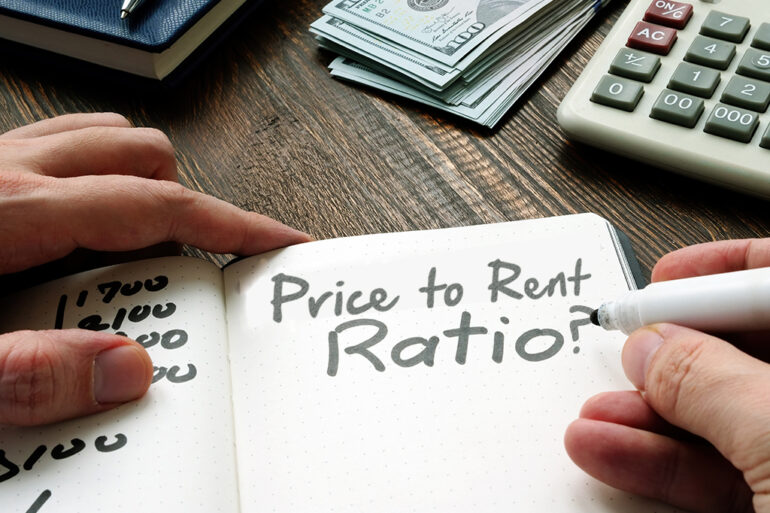What is the Price-to-Rent Ratio and How to Use it to Profit!
Every real estate investor wants to know whether the market they are investing in is a good place to invest or not. So, how do the veteran investors figure it out? With numbers, of course.
Real estate investing is all about the bottom line. This is a numbers game where facts and figures are used to evaluate a property and its quality. Do the numbers point towards growth or a downturn in your real estate investment?
One of the best metrics to use in determining whether a property will perform well, the price-to-rent ratio is used by investors to identify areas that could be good for owning rental property.
In this article, we will look deeper into what a price-to-rent ratio means, what makes it special, and how you can use it to profit.
What Is the Price-to-Rent Ratio?
The price-to-rent (PTR) ratio is an important indicator of a housing market’s health. This metric compares annual gross rent in a specific location to the price of buying houses in the same area.
Investors use the price-to-rent ratio when determining whether it is more cost-effective to buy a specific property for future resale or to just rent it out.
According to Statista, the price-to-rent ratio in the US has been increasing on a quarterly basis in recent years. For example, in the first quarter of 2021, the PTR ratio nationally was 121.8%, which was an 11.3 index point increase from the previous year’s first quarter.
Let’s take a look at how we come up with these figures.
How to Calculate the Price-to-Rent Ratio
Calculating the price-to-rent ratio is straightforward for many investors. The formula is quite simple.
Price-to-Rent Ratio = Average Property Price / (Average Rent Per Month x 12 Months)
For example, if the home sales around Colorado average at $200,000 and the average rent is $1,250 per month, then the price-to-rent ratio is:
$200,000 / ($1,250 x 12) = 13.3
It may not be easy to find data on the price-to-rent ratio for a particular area, but fortunately, Zillow and the United States Department of Labor do most of the legwork for you. Here you can find real-time data on home values, home sales and listings, and even price-to-income ratios.
However, you need to understand that when it comes to the price-to-rent ratio, there is no one size fits all approach to finding the best ratio. Everything depends on what you’re specifically looking for in the real estate market.
With that said, a price-to-rent ratio ranging from 16-20 shows that the average home value is almost level with the average monthly rent. This translates into stable rental space demand and general price affordability.
Cities with these kinds of ratios are secondary markets with above average employment, economic, and population growth rates, making them the perfect location for beginner investors.
What the Price-to-Rent Ratio Tells Investors
The price-to-rent ratio is one of several housing market indicators used by beginner and seasoned investors to gauge the value of a potential rental property. Keeping that in mind, the price-to-rent ratio falls into three broad categories:
- (High) 21 and above
- (Medium) 16 to 20
- (Low) 15 and below
If a certain zip code has a PTR ratio below 15, most residents in the area own their homes rather than rent. This low ratio also means that it may be hard to maintain cash flow since, as an investor, you might experience trouble finding a tenant. The best approach to use when investing in such a market is a fix-and-flip approach since there will be many homebuyers to choose from.
A medium ratio of 16 to 20 shows that the average price of buying is slightly higher than that of renting. The residents in such an area are likely to live in rental properties with very few buying their homes. What this also means is that such a community has above average economic and population growth rates, meaning rent and searching for tenants will never be a problem. Investing in rental property is the best step in this category.
Higher PTR ratios of over 20 mean that properties are too expensive compared to the monthly rent. For this reason, the larger population in such an area will prefer renting property to buying. This in turn makes areas with higher PTR ratios the best for long-term rental properties when it comes to investing.
And with all factors held constant, PTR data becomes more valuable the more specific and focused it gets. For example, whole city or town PTR ratios can help investors identify areas with more potential compared to others. However, calculating detailed neighborhood to neighborhood PTR ratios will be far more helpful within a given market.
Why Is the Price-to-Rent Ratio Important?
By having the PTR ratio for every zip code in the US, an investor can easily identify which properties are the best for rental property investment or fix-and-flip.
Investors use this metric to analyze properties, ROI, and potential markets. However, there are a few things you should keep in mind when it comes to PTR ratios.
First, the ratio does not measure the affordability of a given area. The PTR only measures the economics of renting versus owning. In prime properties, many people are priced out of owning homes, making the PTR ratio irrelevant since renting is the only option for them.
As an investor, the PTR ratio might point you towards buying property for future resale, which is the wrong approach for such property.
Secondly, the PTR ratio moves according to the housing market. This was seen during the 2008 housing crash when the ratio increased drastically.
According to the Bureau of Labor Statistics, certain home rents, prices, and related housing expenditures added to the PTR ratio which, when you think about it, might have predicted the crash.
How to Use the PTR Ratio in Real Estate Investing
You should not rely on the PTR ratio alone when making an investment decision. Like other real estate metrics, there is no one size fits all approach or definite answer to what a good PTR ratio is for investors. The price-to-rent metric is just one of the many formulas investors should use to analyze the financial performance of a property.
Other metrics to consider include:
- Cap Rate
- ROI
- Net Operating Income
- Cash Flow
- Gross Rent Multiplier
- Cash-on-Cash Return
Looking Beyond the Price-to-Rent Ratio
The PTR ratio only measures whether the whole market favors buying or renting. As an investor, you need to stay ready to buy even when the market says otherwise.
Investors should also do research on the general economic performance of the target market. Strong real estate markets have:
- Good neighborhood ranking with low crime rates
- An expanding job market
- Consistent population growth
- A high number of renters
Before You Leave
While the price-to-rent ratio is an important number to know, it is by no means the be-all and end-all when making your final investment decision. There are other important factors to consider such as vacancy rates, expected rents, taxes, fees, closings times, leverage, and cash flow. These factors should be considered in order to determine which areas are most worthwhile for investment.
As a real estate investor, you will have to make sense of the current market and whether it is a good time for you to invest or not. Only you can decide on whether to rent or buy if the situation favors you. The PTR is only one step you should consider when making the final decision.
Now, go calculate the price-to-rent ratio for your portfolio and tell us what you find.








